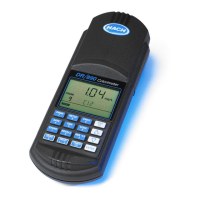22
SECTION 3, continued
reagents. Press the ENTER key to activate this option. The
default setting is off. Chemistries which zero on a reagent
blank do not have this option available.
• STD - Standard Adjust option allows for entry of the value of
the prepared standard. Press the
ENTER key to activate this
option. The default setting is off.
Note: The BLANK and/or
STD options may or may
not be available,
depending on the selected
Hach program; the BLANK
and STD options are
always available for user-
entered programs.
• PRINT (ALL) - Prints all stored data to a printer or
downloads it to a personal computer. The information printed
includes: sample concentration reading, date of sample, time
of sample, units, sample number, program number,
Absorbance, and %T. Refer to Section SECTION 6 for
detailed printing information and to Figure 10 for an example
of a printout. Press the
ENTER key to activate this option.
• USER - Allows access to the User-Entered Program Menu.
Press the
ENTER key to activate this option. See Creating a
New User-entered Program on page 33 for more information.
• DATE - Allows the user to set the date. Press the ENTER key
to activate this option. See Section 2.3.1 for more
information.
• TIME - Allows the user to set the time. Press the ENTER key
to activate this option. See Section 2.3.2 for more
information.
• ERASE (ALL) - This clears all the data previously stored in
memory. Press the
ENTER key to activate this option.
3.1.2 Recall Menu
The recall menu allows access to stored data. Complete
information and instructions for the use of this menu is presented
in SECTION 5 DATA RECALL AND STORAGE.
3.2 Performing an Analysis
The procedures manual provides illustrated, step-by-step
procedures for performing all the factory-entered methods. This
instrument manual has supplemental information on how the
instrument performs the necessary functions, and how to use the
special operating features. Once you are familiar with the

